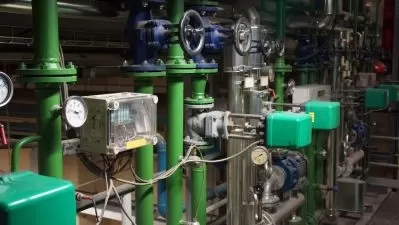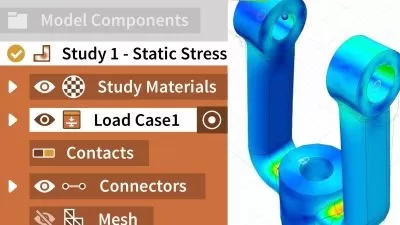Rupture & bursting discs : Optimum Safety & Performance
WR Training
2:39:53
Description
Design, sizing, selection, assembling, installation and operation of rupture discs to ASME and API Codes and Standards
What You'll Learn?
- Learn from WR Training industrial experts what they wrongly calculated during project startup, debottlenecking and commissioning
- Understand rupture disc manufacturers’ literature better and understand their jargon
- Understand how the ASME Boiler and Pressure Vessel Code, Section VIII affects sizing, selection, assembling, testing and installation of rupture discs
- Understand how the API Recommended Practice RP520 affects sizing, selection, assembling, testing and installation of rupture discs
- Become more aware of the potential benefits and pitfalls of the currently available rupture disc technology
- Size and select rupture discs according to the currently available state-of-the-art disc sizing technology
- Make more informed and creative decisions in the selection, sizing, installation and use of rupture discs and their applications
Who is this for?
What You Need to Know?
More details
DescriptionRupture discs should be taken very seriously.
They must always accurately respond to system conditions and prevent catastrophic failure when other instruments and control systems fail to adequately control process limits.
Unfortunately, because of the lack of knowledge and disappearing expertise worldwide, the quality of selection and operation of rupture discs is often insufficient.
This possibly jeopardizes the safety of each of us, living or working in the neighborhood of a process plant.
Proper sizing, selection, manufacture, assembly, test, installation and maintenance of a rupture disc are all critical to obtaining maximum protection.
Designed around a series of practical examples which we work through to a solution, this valuable course is an essential guide to a complete understanding of construction details and functioning of rupture discs.
This understanding is a pre-requisite for the proper sizing, selection, assembly, test, installation and maintenance of rupture discs.
The course presents reference data, technical recommendations and field observations based on our many years of experience in sizing, selecting, testing, installing and operating rupture discs.
The basic formulae and capacity correction factors contained in this course reflect current state-of-the-art rupture discs sizing technology.
Typical disc sizing examples have been included to assist in understanding how specific formulae are applied.
Useful technical data covering terminology, standards, codes, basic design, sizing and selection information, are presented in an easy to use format.
Reference is made to :
ASME Boiler and Pressure Vessel Code, Section VIII, Pressure Vessels
API Recommended Practices RP520 / RP521
This course also cautions the piping designer, the process engineer and any user of pressure relief devices, that the performance of a properly sized and selected rupture disc, can be severely compromised when used in conjunction with improper companion piping or incorrect handling and installation.
Rupture disc installation guidelines and their rationale, as well as some precautions, are offered to ensure optimum performance and safety.
We are confident that this valuable course will help you contribute to the safety of your facility, your fellow workers and yourself.
Thank you for watching. Hope to see you there.
WRÂ Training
Spread the wings of your knowledge
IMPORTANT SAFETY NOTES
It is important to always remember that a rupture disc is a safety device employed to protect pressure vessels or systems from catastrophic failure. With this in mind, the application of rupture discs should be assigned only to fully trained personnel and be in strict compliance with rules provided by the governing Codes and Standards
Rupture discs must be sized, selected and installed by those who have complete knowledge of:
The pressure relieving requirements of the system to be protected
The environmental conditions particular to that installation
Rupture discs sizing and selection is the responsibility of:
The process engineer
The user of the system to be protected
Sizing and selection of rupture discs should not be based on arbitrarily assumed conditions or incomplete information. Merely having a mandatory rupture disc installation does not make a system safe
Who this course is for:
- Chemical, Process, Petroleum Engineers
- Design Engineers
- Piping Engineers
- Plant Engineers
- Plant operators
- Mechanics
- Safety professionals
- Pressure vessels and piping inspectors
Rupture discs should be taken very seriously.
They must always accurately respond to system conditions and prevent catastrophic failure when other instruments and control systems fail to adequately control process limits.
Unfortunately, because of the lack of knowledge and disappearing expertise worldwide, the quality of selection and operation of rupture discs is often insufficient.
This possibly jeopardizes the safety of each of us, living or working in the neighborhood of a process plant.
Proper sizing, selection, manufacture, assembly, test, installation and maintenance of a rupture disc are all critical to obtaining maximum protection.
Designed around a series of practical examples which we work through to a solution, this valuable course is an essential guide to a complete understanding of construction details and functioning of rupture discs.
This understanding is a pre-requisite for the proper sizing, selection, assembly, test, installation and maintenance of rupture discs.
The course presents reference data, technical recommendations and field observations based on our many years of experience in sizing, selecting, testing, installing and operating rupture discs.
The basic formulae and capacity correction factors contained in this course reflect current state-of-the-art rupture discs sizing technology.
Typical disc sizing examples have been included to assist in understanding how specific formulae are applied.
Useful technical data covering terminology, standards, codes, basic design, sizing and selection information, are presented in an easy to use format.
Reference is made to :
ASME Boiler and Pressure Vessel Code, Section VIII, Pressure Vessels
API Recommended Practices RP520 / RP521
This course also cautions the piping designer, the process engineer and any user of pressure relief devices, that the performance of a properly sized and selected rupture disc, can be severely compromised when used in conjunction with improper companion piping or incorrect handling and installation.
Rupture disc installation guidelines and their rationale, as well as some precautions, are offered to ensure optimum performance and safety.
We are confident that this valuable course will help you contribute to the safety of your facility, your fellow workers and yourself.
Thank you for watching. Hope to see you there.
WRÂ Training
Spread the wings of your knowledge
IMPORTANT SAFETY NOTES
It is important to always remember that a rupture disc is a safety device employed to protect pressure vessels or systems from catastrophic failure. With this in mind, the application of rupture discs should be assigned only to fully trained personnel and be in strict compliance with rules provided by the governing Codes and Standards
Rupture discs must be sized, selected and installed by those who have complete knowledge of:
The pressure relieving requirements of the system to be protected
The environmental conditions particular to that installation
Rupture discs sizing and selection is the responsibility of:
The process engineer
The user of the system to be protected
Sizing and selection of rupture discs should not be based on arbitrarily assumed conditions or incomplete information. Merely having a mandatory rupture disc installation does not make a system safe
Who this course is for:
- Chemical, Process, Petroleum Engineers
- Design Engineers
- Piping Engineers
- Plant Engineers
- Plant operators
- Mechanics
- Safety professionals
- Pressure vessels and piping inspectors
User Reviews
Rating
WR Training
Instructor's Courses
Udemy
View courses Udemy- language english
- Training sessions 45
- duration 2:39:53
- Release Date 2024/03/11











